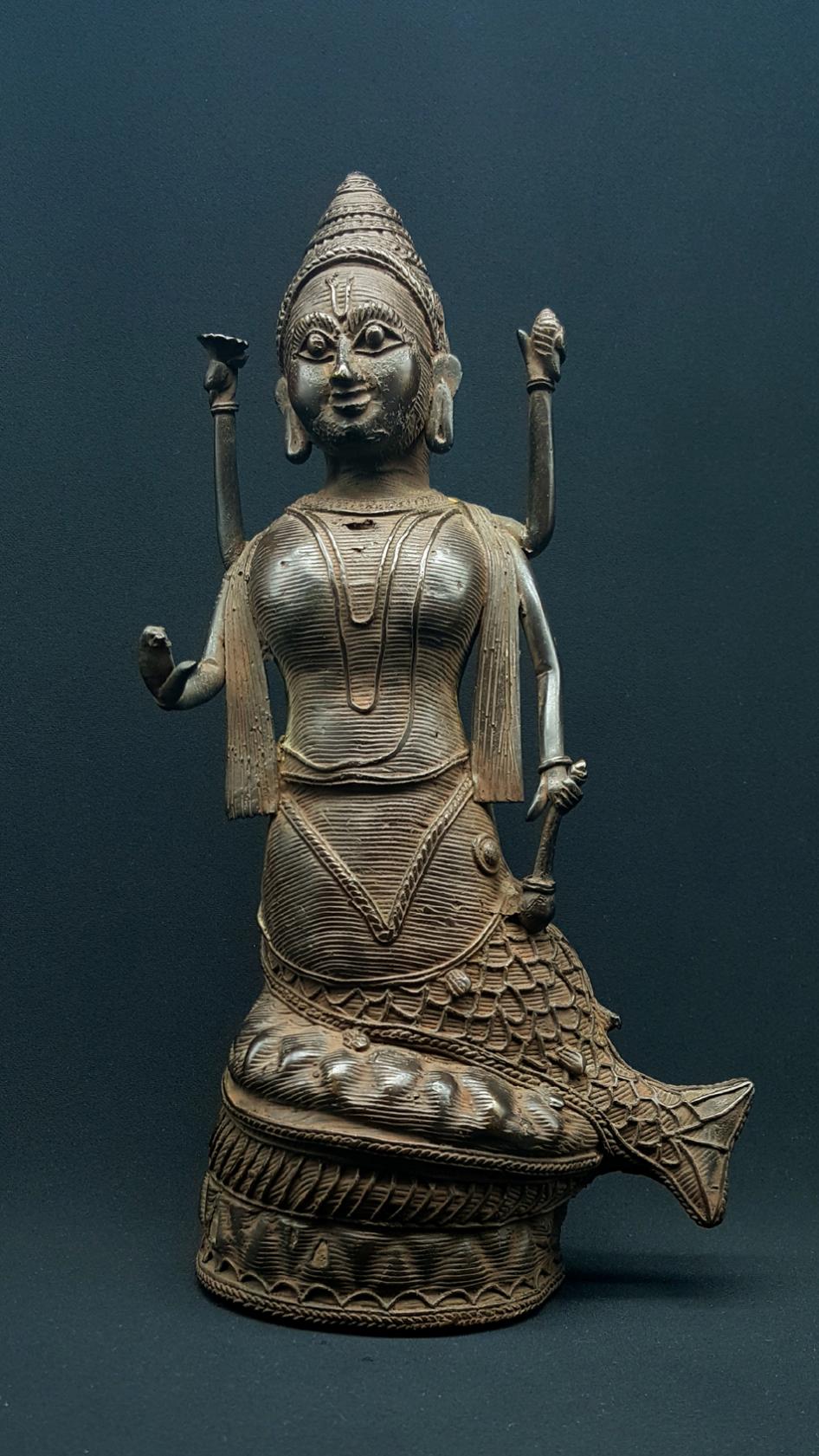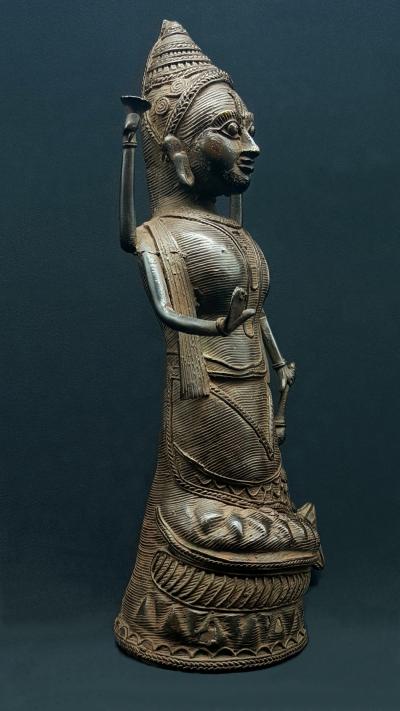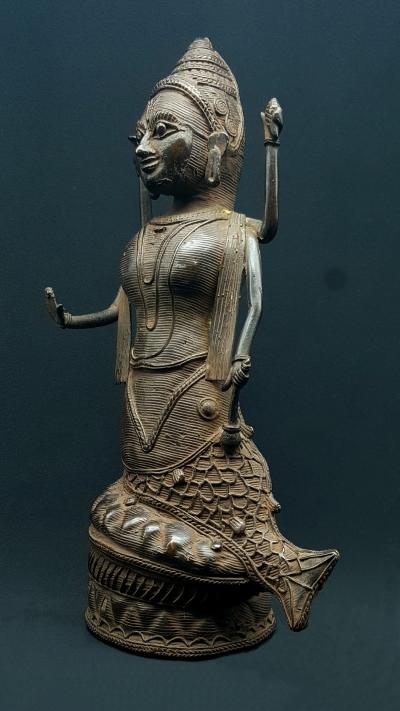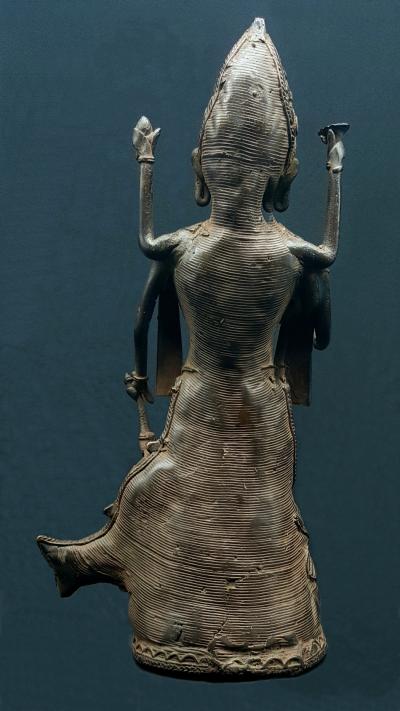Statue Vishnou Matsya
Le poisson, sauveur des hommes lors du déluge
€295.00
Matsya seconde incarnation de Vishnou symbolise le sauveur du monde et du déluge mais aussi la préservation des Vedas : grande finesse de réalisation et belle patine. En savoir plus...
Hauteur : 26.3 cm
Poids : 1,810 Kg
Art sacré
Cire perdue
Origine : Bastar - Inde
Livraison gratuite UE, Norvège et Suisse
Description
Vishnou dans le panthéon hindou représente le deuxième aspect de la trimurti (avec Brahma et Shiva): Vishnou est celui qui préserve, protège, maintient la vie. Il est le garant de l'ordre qui permet à chacun de s'épanouir. Attentif, bienveillant, il rend justice, assure la paix et peut aussi se révéler un guerrier redoutable si besoin.
Les avatars de Vishnou sont l’une de ses caractéristiques : dès que le monde manifesté traverse une période destructrice, Vishnou intervient sous une forme particulière afin de rétablir l’harmonie, l’équilibre qui permet à nouveau, à la vie de se déployer.
Dans ce cycle, Vishnou, s’est incarné dans un corps vivant dix fois : le poisson, la tortue, le sanglier, l’homme lion, le nain, Râma à la hache ou Parashurâma, Rama-Krishna, Bouddha et Kalki (encore à venir).
L'art Dokra : un savoir millénaire dans la fabrication de statues
Cet art tribal indien artisanal n'a pas changé depuis des millénaires (+ de 4000 ans) et la technique utilisée est toujours celle de la cire perdue : un modèle grossier en argile est réalisé puis recouvert de cire par l'artiste qui va lui donner sa forme définitive avec ses détails. L'ensemble est à nouveau recouvert d'un mélange argileux puis chauffé dans un foyer ouvert où un alliage cuivreux sera coulé. Voir Blog.
Les objets produits par les artistes Dokra peuvent être de nature usuels : coupelle, bougeoir... des instruments de musiques (cuivres), ou bien artistiques tels que des bijoux, des animaux : chevaux, éléphants, tortues..., des statues d'hommes et femmes représentant des scènes de vies quotidiennes et des divinités hindous adoptées par les tribus : Ganesh, Lakshmi,...
Cette statuette tribal Dokra de Matsya Vishnou symbolise : le poisson, sauveur du déluge et des Vedas.
Il existe plusieurs récits concernant la venue de Matsya : l’une d’elles raconte que Manu, considéré comme le premier humain sur Terre (tel Adam) trouva un petit poisson : celui ci lui demanda de le protéger lui indiquant qu’il le sauverait du déluge bien des années plus tard. Manu veilla alors sur Matsya qui grandit et pris une telle place que seul l’océan pouvait le contenir. Le temps venu, tel Noé, Manu construisit un bateau, y logea les sages, les plantes et les animaux. C’est ainsi que Vishnou sauva l’humanité mais aussi les Védas que le démon Haryagrîva avait caché dans l’océan.
Posture Debout, Vishnou prend ici une forme souveraine. Il est serein, apaisé.
Gestes Coté droit, bras levé, la main tient le lotus. Sa première main gauche porte la massue. L’autre main gauche, coude replié, tient la conque tandis que la seconde main droite fait le geste de protection, d'absence de peur.
Socle Les dieux ne touchent jamais le sol : la terre est le domaine des êtres de chair et de sang.
Couvre-chef Couronne en forme tiare : Kiritamukuta - symbole de royauté
Habillements Une grande sobriété : le cordon sacré (yajnopavita), quelques colliers très discrets ainsi qu’une fine étole couvre les épaules de Vishnou Matsya.
Attributs et armes
La massue : Kaumodaki « La massue est la puissance de connaître » (Vishnu Purdna).
Arme primitive, certes, incarnation de la force brute mais aussi de la maîtrise des forces instinctives, physiques et de la nature. C’est l’arme de la maîtrise du mental par excellence. C’est aussi l’arme de prédilection de Kali.
La conque est reliée au souffle primordial, à l'origine de la vie. Panchajanya (Née des cinq éléments), le son grave éloigne les démons mais surtout symbolise l’infini et l’expansion (les anneaux partent d’un point pour s’élargir sans fin). Elle provient de l’eau, à l’origine de la création. Le son qu’elle produit est considéré comme le son primordial. La conque est reliée à l’élément eau.
Le lotus : Padma, symbolise la pureté, la beauté, la perfection. Il est le sein maternel, la matrice d'où viennent toutes choses. C'est le siège du principe féminin, la Shakti.
Le lotus donne une fleur de toute beauté, alors qu'il provient d'un environnement marécageux, obscur, repoussant : il représente donc la possibilité de transformation, d'élévation.




